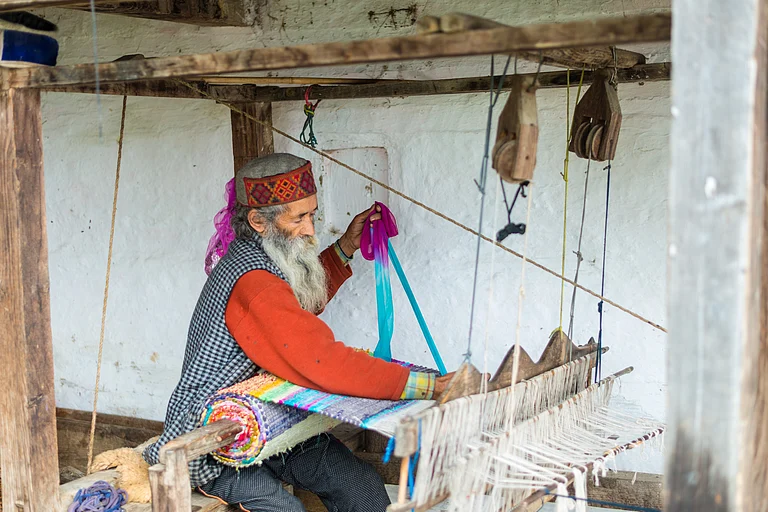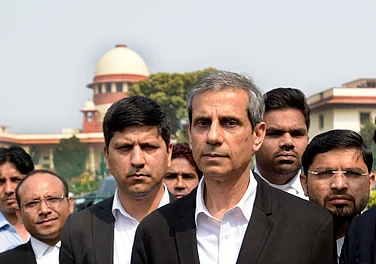The scars of devastation caused by high-intensity cloudbursts, landslides, and flash floods lay bare in Mandi. The pain of losing loved ones is difficult to imagine. Land, orchards, houses, and link roads lie in ruins, buried under the rubble.
It's a trail of economic destruction and human tragedies that one can see in the mountains of Himachal Pradesh, this time again.
The monsoon-linked disasters—furious cloudbursts, mostly striking in the silence of the night, have pushed native hill families to the very edge of survival. Nature’s fury has shattered not only the hopes of native hill families but also their livelihoods.
The cloudburst in Mandi, a 1527 AD urban town, known for its mythological significance, is a worrying sign of how Himachal Pradesh has become vulnerable to disasters. The urban settlements are also at grave risk. Shimla's building collapse and cloudburst swept away the Shiv Bhawdi temple. Twenty-one persons, six of a single family, died in the heart-wrenching tragedy.
The severity of recurrent disasters is rather alarming. Official responses to disaster management and minimizing their impact on infrastructure, livelihoods, and the human population are woefully insufficient. There is no reliable system in place to minimise the loss of fatalities.
In 2023, it was the Kullu district bearing the brunt of the worst-ever disasters triggered by cloudbursts, incessant rains, flash floods, and landslides. More than 500 people lost their lives. Economic loss was estimated to be over 10,000 crore rupees.
Two years on, Mandi has emerged as the epicenter of terrifying extreme weather events, with cloudbursts showing no signs of abating.
Faced with an unforeseen challenge, Chief Minister Sukhwinder Singh Sukhu constituted a cabinet sub-committee to examine and suggest measures for strengthening the state’s disaster preparedness and rehabilitation mechanisms, besides steps to minimize the impact of natural calamities on human lives and also save infrastructure.
Headed by Revenue Minister Jagat Singh Negi, the report of the committee was accepted by the cabinet, which held its meeting on July 29 and reviewed, in detail, the situation created by the monsoon fury, cloudbursts, and flash floods, which have claimed 170 lives till now this season alone.
One of the key recommendations of the committee relates to the need for conducting statewide structural safety audits of residential, public, and institutional buildings.
“Based on these audits, retrofitting measures should be undertaken to minimize the risk of structural damage during disasters,” it said.
Noting that the biggest damage after any disaster, whether cloudburst, flash flood, or landslide, occurs to infrastructure. The committee recommended improving structural resilience. Only hazard-resilient infrastructure should be permitted in the sensitive areas prone to frequent disasters, landslide zones, and high‑risk mountainous terrain.
The other two significant recommendations also include prioritising pre‑disaster planning and establishing an early warning system instead of reactive relief, besides setting up a dedicated landslide and flood‑forecasting unit within the state.
But the climate change experts and geologists believe that setting up committees is nobody in the government system and takes the onus of enforcing the recommendations. Even the legislative measures to regulate construction and prevent illegal constructions have remained an eyewash, also in towns like Shimla, the erstwhile summer capital of British India.
“The response to frequent disasters is reactive rather than preventive. There are inherent gaps in preparation and planning, even prompt relief efforts. Practically, there is no disaster management; it’s only post-disaster, and that too lacks effectiveness,” says Tarun Shridhar, a retired IAS and former Secretary to the Government of India (GoI).
He calls natural calamities a 'myth', as most of the disasters are man-made.
“Time and again, the experts have issued warnings. But no lessons learned. Their reports are gathering dust in the files and papers. The development trajectory is highly unsuited to the fragile hills. Unfortunately, development has become a synonym of civil construction, unregulated and ugly at that; a sure-shot recipe for disasters,” Shridhar says.
Reports say since 2018, the state has experienced nearly 150 cloudbursts, 300 flash floods, and over 5,000 landslides, taking a heavy toll of lives and property damages in districts like Kullu, Mandi, Kinnaur, Chamba, and Lahaul‑Spiti.
Multiple studies done by agencies like the Central Water Commission (CWC), the Geological Survey of India (GSI), the Wadia Institute of Himalayan Geology, and the HP State Council for Science, Technology, and Environment in their reports asked for the proper vulnerability and load-carrying capacity of the areas before sanctioning development and infrastructure projects.
“We have been asking for a decisive shift to resilient planning. You can't do much to stop extreme weather events, viz., torrential rains or cloudbursts, but you can avoid those actions that amplify the disaster risks. These include deforestation, steep vertical hill cutting, indiscriminate dumping of debris, and encroachments on the riverbeds,” says Suresh Attri, a climate change scientist and Joint Member Secretary of the HP State Council for Science and Technology.
Attri admits that extreme weather events are becoming increasingly frequent in the Himalayan region. While cloudbursts are a natural occurrence during the monsoon and rainfall is a global phenomenon, the focus, he suggests, should be on adapting to these changing conditions. The development practices should be disaster-, earthquake-, and landslide-resilient, minimizing human interference with nature.
Virender Kumar Paul, Director, School of Planning and Architecture, New Delhi, who hails from Himachal Pradesh, feels that the hill state is experiencing disaster risks of different natures. The occurrence of landslides, cloudbursts, floods, and land subsidence across the state is far more frequent and impactful.
Giving reasons, he said, "Consistent ignorance of extensive urbanization beyond the capacity, proliferation of built mass causing heat islands close to hitherto snow-clad ranges, and depletion of groundwater altering vegetation patterns is unacceptable. Nobody seems to know what to do and where to begin, but that is not right. Willingness is marred by a quagmire of vested interests."
He says the focus should shift from urbanization to protecting major natural heat sink reserves.
When contacted, Minister for Town and Country Planning Rajesh Dharmani said the cabinet held a three-hour-long deliberation on disaster management and recommendations of the cabinet subcommittee.
The government has approved an immediate structural safety audit of buildings across the state. “We have decided to explore options to set up an integrated safety agency to enforce resilient building codes, prepare forecasting and pre-disaster planning, and adopt robust post-disaster relief alone. The center has to liberally fund the state for this,” he strongly feels.





























